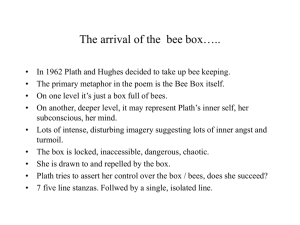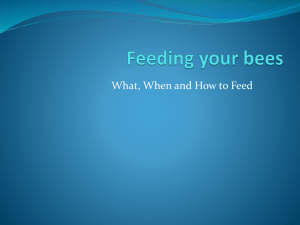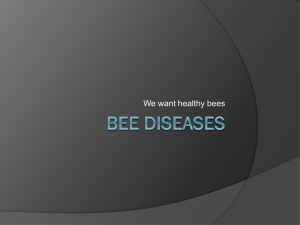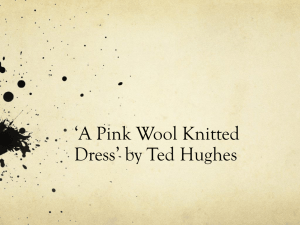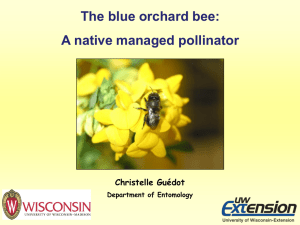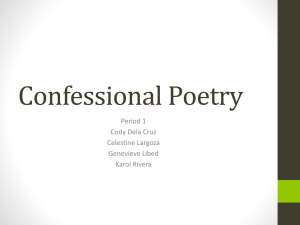Arrival of the Bee Box - Miss O` Connell`s English Class
advertisement
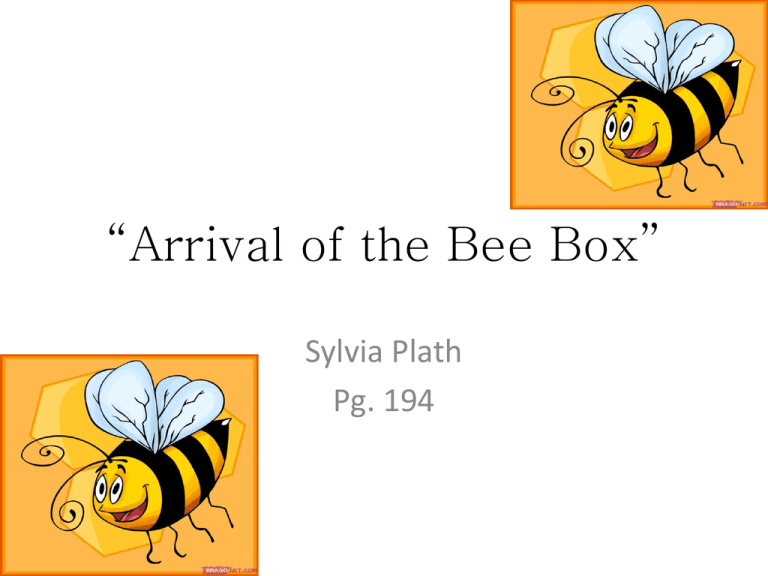
“Arrival of the Bee Box” Sylvia Plath Pg. 194 Content Summary • In this poem, Sylvia Plath expresses a desire to be in control. She feels she has to deal with a dangerous situation – the arrival of a bee box. • At first she is not in control. She panics. • She has a debate with herself and then she makes a calm decision – to set them free the following day. Verse One • The story of the poem deals with a bee box. In the first stanza she states that it looks like ‘square’, like a ‘midget’s coffin’ • It is heavy and noisy: ‘such a din in it’. The word ‘coffin’ suggests something dark, morbid. • The overall description of the bee-box is strange and disturbing. She is in fear of the contents. Verse Two • In the second stanza, the bee box both frightens and attracts Plath. She stares in at the bees through a little wire grid. • The box is ‘locked’ because its contents are ‘dangerous’. Yet Plath ‘can’t keep away from it’. She examines the box and considers opening it. • Is scares her, she feels she has to 'to live with it overnight'. Verse Three • In the third stanza, she regards the bees as angry slaves that seek release and revenge: ‘Black on black, angrily clambering’. • Through the wire grid she sees darkness. She imagines the bees are like the shrunken hands of African slaves. Verse Four • The buzzing noise puts her off releasing the bees. She fears their bee language and now regards them as an aggressive Roman mob. • She describes their language as ‘unintelligible’. • Her exclamation, 'small, taken one by one, but my god together!' reveals a fear of being attacked by these 'minute' [tiny] creatures. The swarm terrifies her. Verse Five • In the fifth stanza she sidesteps the problem: ‘I am not a Caesar’. • It took a powerful ruler like Caesar to master the mobs of roam. • Then Plath introduces a new image for the bees. She imagines that the bees are maniacs and that she can send them back: ‘I have simply ordered a box of maniacs’. As her nerves steady, she realises she can starve them to death and ignore them: ‘They can die, I need feed them nothing’. • “Maniacs” – patients in mental asylum • Maniacs are not as bullying as a Roman mob. They are far less threatening than an army of vengeful African slaves. • Plath’s imagery shows that her state of panic is gradually reducing. • At the end of the fifth stanza, Plath begins to feel powerful again, in a negative sense: ‘I am the owner.’ Verse Six • Plath feels different. • She imagines the bees are ‘hungry’ rather than ‘angrily clambering’. Now she can see herself undoing the locks. • She realises the bees will fly to where they will get honey and leave her alone. They will ignore her, especially if she stands there like a tree. They will fly towards flowering plants. Verse Seven • Plath accepts her role as beekeeper. She realises she will wear her protective beekeeper’s ‘suit’ and ‘veil’. NOT AFRAID • She seems to be coming to terms with her task. She decides she will release the bees, to allow them to find a source of honey. • She also thinks they are likely to ignore her. • By freeing the bees she will be a ‘sweet God’ or a kind person.... • By being ‘sweet’, she resembles the honey that the bees are after, since honey is sweet. • Could this sweetness see her as a target? • In the final single line, she states that the box is ‘temporary’ because she will release the bees in the morning. • She concludes that the bees will not stay locked in the box. • http://www.youtube.com/watch?v=dARaI7nDFI Getting inside the poet’s head... • If we take the bee box as representing Plath’s mind then we can track her own feelings to her interior disturbances. • She fears her own thoughts [the bees!!!] • She sees them as dark and dangerous • She attempts to control them and set them free • However she may be in danger of them attacking her sweetness as a “sweet God”. • The box is temporary – her mind is only sometimes troubled? BEE BOX= HER MIND BEES = HER THOUGHTS Language • As with all of Plath’s poetry it is carefully structured using multiple techniques giving it a layered textured feel. • ‘The Bee Box’ has internal rhyme thread throughout, examples include: ‘Square as a chair’, ‘box is locked,’ ‘my eye’, ‘appalls me most of all,’ ‘mob…god,’ and ‘blonde colonnades’. • The ragged/irregular nature of the line rhyming shows the poet’s feelings of being broken up inside with fears. Onomatopoeia and Sibilance • The sound here cleverly imitates the buzzing Plath hears in the bee box: ‘It is the noise that appalls me most of all, The unintelligible syllables.’ • The ‘s’ sounds create a buzz saw effect, like a buzzing swarm of bees. Therefore these two lines are also an example of Sibilance [repetition of ‘s’ sounds]. • The last two words sound just like a humming swarm of bees. The ‘ll’, ‘n’ and ‘s’ sounds create a sound effect of thousands of bees humming together. When the sound of the words echoes meaning, it is called ‘Onomatopoeia’. • In the first stanza, Plath simply states a fact with the image of the 'clean wood box'. • Then she uses a simile in which she compares the box to a square chair: 'square as a chair'. • She then uses some unusual comparisons or metaphors for the box: “coffin of a midget or a square baby…’ • These morbid images show her attitude to the bee box. The words ‘coffin’ and ‘square baby’ show that Plath looks at the bee box in a disturbed and disturbing way. Imagery • There are many dramatic images of fear. • There are also factual images of the bees and of nature. • There are many contrasting [different] images of the bees Bee imagery • Plath uses three comparisons in stanzas three, four and five. She calls the bees black slaves, a Roman mob and maniacs • The first comparison reminds her of African slaves. Plath plays the role of slave trader. The bees resent their captivity and agitate or angrily stir up trouble. In this comparison, Plath feels that the bees are dangerous. Her fear is at its highest here. Bee imagery 2 • Plath develops this comparison by imagining a Roman Emperor facing this mob as they protest angrily in Latin. [simile] • This comparison is less terrifying than the previous. She admits, ‘I am not Caesar’. For a moment, she was on a power trip, but decides that is pointless. • Later, Plath rediscovers her sense of power over the bees in the final stanza with her image of herself as a ‘God’ in control of the bees Bee imagery 3 • The third comparison is with a hospital for the insane: ‘I have simply ordered a box of maniacs’. • This comparison is based on her personal experience of being in a mental asylum. She is feeling more comfortable now, as she can starve the ‘maniacs’. • The word ‘simply’ shows her growing selfcontrol. The bees are not such a threat anymore. • Her dark spells and dark thoughts conjure up feelings of fear and trauma for her. • The bees, as a whole, fear her. Her dark thoughts scare her. She knows they are necessary to reveal (to herself). She hopes once she addresses these dark, “clambering” thoughts she will be freed... THEMES!!! 1.Mental anguish • Depicts mental turmoil (again!!) • Sight & sound of bees fill speaker with dread. • Unlike mental anguish in “Child” (hopelessness) there is a note of hope here. • The speaker can overcome her fear by releasing them. • She is frozen by her terror of them but releasing them will conquer her fear. • If she can overcome fear of bees she may be able to overcome her deeper mental turmoil. • Self-destructive thoughts: a) Inadequacy: “I am no Caesar” b)wants to leave behind the human condition, to become a tree a “laburnum” so she can leave her troubles behind her • She wants to give up real life in favour of becoming a plant (“Poppies”) 2. Theme of poetic inspiration • This poem could deal with poetry and the unconsciousness. • Plath believed it was necessary to explore the darkest part of the mind to write poetry. • She felt this was a dangerous business for it risked disturbing all kinds of inner demons. • Bee-box = hidden aspect of the mind? • Bee-box might be our innermost thoughts – ones we ignore unless we begin to explore them. • Disgusted by bee-box, disgusted by inner thoughts. • Unleashing inner demons. 3. Psychic landscapes: • Plath uses scenes from the outside world that represent what is in her head. • Box = metaphor of her turmoil filled mind. • Bees = her thoughts which are “angrily clambering” • Dark, angry and negative emotions. • By releasing this negativity she may be freed from living hell.
